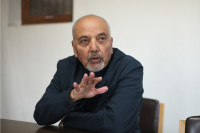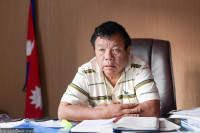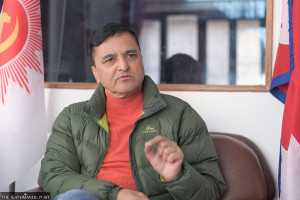Interviews
Keshav Acharya: If we can achieve four percent growth and maintain inflation at seven percent, I will be happy
‘Spending capacity of provincial and local governments should be strengthened as they don’t have technical knowhow.’.png&w=900&height=601)
Prithvi Man Shrestha
The Covid-19 pandemic and subsequent measures imposed to limit its spread have brought the economy to a standstill. Most economic activities have halted and they are unlikely to resume soon, given that Covid-19 cases in the country continue to rise. The economic impacts are global, and countries like Nepal, which depend on remittance and imports, are expected to be hit especially hard.
Prithvi Man Shrestha spoke to economist Keshav Acharya, who served as chief economic advisor to Surendra Pandey during his tenure as finance minister, about the impacts of the lockdown and the Covid-19 crisis, and the upcoming budget. Acharya was the executive director of Nepal Rastra Bank and is currently senior programme adviser at the Economic Policy Incubator, an economic policy advisory think tank. He is also a board member of Nepal Economic Association.
The government will present the budget for the upcoming 2020-21 fiscal year based on its policies and programmes where it has prioritised four areas—health, education, employment and economic recovery. Are the priorities right?
Given the Covid-19 pandemic, the priorities set by the government are right. If these priorities translate into creating jobs in the agriculture sector and public works, they will contribute to the gross domestic product and help in local capital formation.
Our problem is that the service sector comprises 55 to 66 percent of the GDP. But the service sector won’t be able to recover immediately even if the government lifts the lockdown. Cinema halls and department stores are likely to remain closed while travel and tourism won’t see any activity for a long time as people will likely not be coming out of their homes freely until Tihar. A focus on agriculture and industry would compensate for the losses from the service sector.
One of the biggest concerns for Nepal is creating employment amid job losses at home and abroad. The government's focus is on creating large-scale employment under the Prime Minister’s Agriculture Modernisation Programme and providing seed funds for returnee migrant workers. What are your recommendations for job creation?
The majority of people who’ve gone abroad for jobs decided to leave because they were tired of engaging in the agriculture sector for long, as its output was minimal. There is marginal productivity in agriculture. If the government is ready to modernise agriculture, then there are options to employ more people. Hundreds of thousands of hectares of land are currently barren because there are not enough people to cultivate them. A local government in Gulmi is encouraging people to engage in farming during the lockdown by offering cash subsidies for every ropani of cultivated land.
We will need agricultural tools worth billions of rupees, but migrant workers are unlikely to invest in these tools. Is the government ready to help? The government needs to ensure agricultural input, along with a market for products and access to roads and electricity. For this, the agriculture budget needs to be substantially increased.
Another area where employment can be generated is in river embankment projects. By employing engineers, local governments can participate in building embankments. Jobs can also be created in building infrastructure like roads, electricity distribution networks, water pipelines, telephone wires and sewage facilities. They should be developed under a single package. This could create a large number of jobs, possibly 300,000-400,000, at the local and provincial levels.
With the Covid-19 pandemic, the future of labour migration is itself at risk. Nepal depends heavily on remittance, not just for consumption but also for foreign exchange reserves.With tourism, another major source of foreign exchange, also drying up, how will Nepal, a country that depends heavily on imports, fare?
The country’s foreign exchange earnings from remittance, exports, tourism and foreign aid are all going to be affected by the Covid-19 pandemic. I had thought that there might be more aid from multilateral donors but I am no longer confident that their support will grow substantially as there is now more competition for their resources.
Given this context, the government needs to re-prioritise the use of foreign exchange. The focus should be on procuring medical supplies, food items and capital goods. If there is extreme pressure, the government needs to be ready to impose a quota on the availability of foreign exchange.
Given the possibility of decreased foreign aid and low growth in revenue, there is a call to decrease the size of the budget. What is your suggestion?
I used to advocate big budgets and big infrastructure projects. But our capacity for expenditure is very limited. The Parliamentary Finance Committee has asked the government to introduce a budget of Rs1.7 trillion, but I don’t believe the government will be able to spend that amount either. As we will not be working well until Tihar, we should not go for an ambitious budget. If we can achieve four percent growth next year and maintain inflation at seven percent, I will be happy.
Remittance has been key to alleviating poverty in rural Nepal. As remittance shrinks, what can be done for vulnerable communities in the new budget?
The government says that 18 percent of the population is below the poverty line. Due to the lockdown in the last two months, I predict that that population has now increased to 20-21 percent, as many people have lost jobs in the last two months. In order to help them, the government must remodel the Prime Minister’s Employment Programme in line with India’s Mahatma Gandhi Rural Employment Guarantee Programme, which is a very transparent programme.
The Covid-19 pandemic has shown the importance of local and provincial governments. Should resources for provincial and local governments be increased?
My recommendation is that provincial governments be allowed to implement any projects below Rs5 billion and local governments be allowed to implement projects below Rs1 billion. The budget should be allocated accordingly. At the same time, the spending capacity of provincial and local governments should also be strengthened because they don’t have technical knowhow regarding feasibility study and project appraisals, for which the federal government can send technical staff or assign retired bureaucrats.
The country has been on lockdown for the last two months but the government has yet to come out with a proper plan to lift or ease restrictions. What do you recommend?
Despite the lockdown, we will have to bring production into operation, along with distribution channels for goods that help in import substitution and promote exports. For this, proper health protocols should be in place. If the government does not believe in the private sector’s distribution channels, the army or police can run these services. The security agencies can deliver raw materials to the factories and help bring finished products to the market. We should not suspend all economic activities completely.
The private sector is not happy with the policies and programmes, saying that it lacks measures to help them. What can the government do for the private sector at a time when the government itself is facing a resource crunch?
I am sympathetic to the private sector. The government seeks to recover taxes in whatever way possible but when the private sector is facing hardship, the government is hesitant. Due to the limitation of resources, the government may not be able to help the private sector with cash, but it can extend the tax payment deadline, provide interest subsidies and guarantee bank loans through the Deposit Insurance and Credit Guarantee Corporation.
Currently, corporate income tax for banks is 30 percent and 25 percent for other sectors. India has already decreased corporate tax to 20 percent. As we are trying to attract foreign direct investment, we need a more favourable tax regime and better infrastructure than India, which also has access to the sea. The government can reduce corporate tax to 22 percent.




 13.12°C Kathmandu
13.12°C Kathmandu












